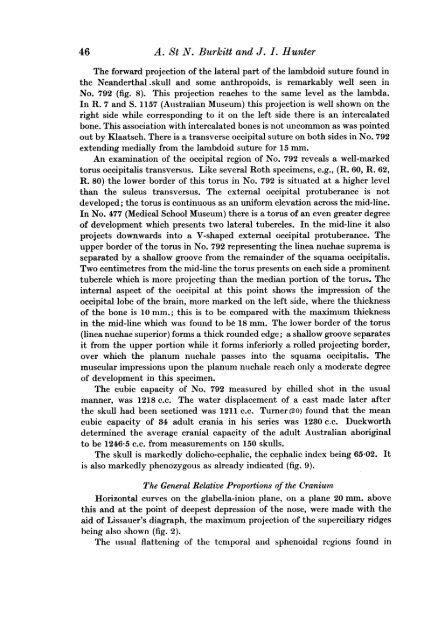THE DESCRIPTION OF A NEANDERTHALOID AUSTRA-
THE DESCRIPTION OF A NEANDERTHALOID AUSTRA-
THE DESCRIPTION OF A NEANDERTHALOID AUSTRA-
Create successful ePaper yourself
Turn your PDF publications into a flip-book with our unique Google optimized e-Paper software.
46<br />
A. St N. Burkitt and J. I. Hunter<br />
The forward projection of the lateral part of the lambdoid suture found in<br />
the Neanderthal .skull and some anthropoids, is remarkably well seen in<br />
No. 792 (fig. 8). This projection reaches to the same level as the lambda.<br />
In R. 7 and S. 1157 (Australian Museum) this projection is well shown on the<br />
right side while corresponding to it on the left side there is an intercalated<br />
bone. This association with intercalated bones is not uncommon as was pointed<br />
out by Klaatsch. There is a transverse occipital suture on both sides in No. 792<br />
extending medially from the lambdoid suture for 15 mm.<br />
An examination of the occipital region of No. 792 reveals a well-marked<br />
torus occipitalis transversus. Like several Roth specimens, e.g., (R. 60, R. 62,<br />
R. 80) the lower border of this torus in No. 792 is situated at a higher level<br />
than the sulcus transversus. The external occipital protuberance is not<br />
developed; the torus is continuous as an uniform elevation across the mid-line.<br />
In No. 477 (Medical School Museum) there is a torus of an even greater degree<br />
of development which presents two lateral tubercles. In the mid-line it also<br />
projects downwards into a V-shaped external occipital protuberance. The<br />
upper border of the torus in No. 792 representing the linea nuchae suprema is<br />
separated by a shallow groove from the remainder of the squama occipitalis.<br />
Two centimetres from the mid-line the torus presents on each side a prominent<br />
tubercle which is more projecting than the median portion of the torus. The<br />
internal aspect of the occipital at this point shows the impression of the<br />
occipital lobe of the brain, more marked on the left side, where the thickness<br />
of the bone is 10 mm.; this is to be compared with the maximum thickness<br />
in the mid-line which was found to b6 18 mm. The lower border of the torus<br />
(linea nuchae superior) forms a thick rounded edge; a shallow groove separates<br />
it from the upper portion while it forms inferiorly a rolled projecting border,<br />
over which the planum nuchale passes into the squama occipitalis. The<br />
muscular impressions upon the planum nuchale reach only a moderate degree<br />
of development in this specimen.<br />
The cubic capacity of No. 792 measured by chilled shot in the usual<br />
manner, was 1218 c.c. The water displacement of a cast made later after<br />
the skull had been sectioned was 1211 c.c. Turner(20) found that the mean<br />
cubic capacity of 34 adult crania in his series was 1230 c.c. Duckworth<br />
determined the average cranial capacity of the adult Australian aboriginal<br />
to be 1246-5 c.c. from measurements on 150 skulls.<br />
The skull is markedly dolicho-cephalic, the cephalic index being 65-02. It<br />
is also markedly phenozygous as already indicated (fig. 9).<br />
The General Relative Proportions of the Craniumn<br />
Horizontal curves on the glabella-inion plane, on a plane 20 mm. above<br />
this and at the point of deepest depression of the nose, were made with the<br />
aid of Lissauer's diagraph, the maximum projection of the superciliary ridges<br />
being also shown (fig. 2).<br />
The usual flattening of the temporal and sphenoidal regions found in

















